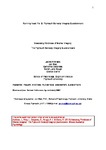Assessing Vividness of Mental Imagery: The Plymouth Sensory Imagery Questionnaire
Date
2014-11-01Author
Subject
Metadata
Show full item recordAbstract
Mental imagery may occur in any sensory modality, although visual imagery has been most studied. A sensitive measure of the vividness of imagery across a range of modalities is needed: the shorter version of Bett’s QMI (Sheehan, 1967) uses outdated items and has an unreliable factor structure. We report the development and initial validation of the Plymouth Sensory Imagery Questionnaire (Psi-Q) comprising items for each of the following modalities: Vision, Sound, Smell, Taste, Touch, Bodily Sensation and Emotional Feeling. An Exploratory Factor Analysis on a 35-item form indicated that these modalities formed separate factors, rather than a single imagery factor, and this was replicated by confirmatory factor analysis. The Psi-Q was validated against the Spontaneous Use of Imagery Scale (Reisberg, Pearson & Kosslyn, 2003) and Marks’ (1995) Vividness of Visual Imagery Questionnaire-2. A short 21-item form comprising the best three items from the seven factors correlated with the total score and subscales of the full form, and with the VVIQ-2. Inspection of the data shows that while visual and sound imagery is most often rated as vivid, individuals who rate one modality as strong and the other as weak are not uncommon. Findings are interpreted within a working memory framework and point to the need for further research to identify the specific cognitive processes underlying the vividness of imagery across sensory modalities.
Description
Collections
Publisher
Place of Publication
Journal
Volume
Issue
Pagination
Author URL
Recommended, similar items
The following license files are associated with this item:


